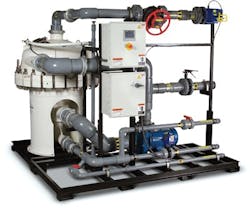About the author: Benjamin Orton is global product marketing manager - filtration for Dow Water & Process Solutions. Orton can be reached at [email protected].
In a world where global manufacturing demand for water is expected to increase by 400% from 2000 to 2050, manufacturers including food and beverage companies are under pressure to reduce, reuse and recycle water. These companies generate large volumes of dirty wastewater high in total suspended solids (TSS) and/or biochemical oxygen demand (BOD).
The dirtier the wastewater, the costlier it is for municipalities to clean, so it is no surprise when they pass that cost along. The average nationwide “excess TSS” surcharge rate increase is 5.6% per year—twice the Consumer Price Index of 2.4%. Additionally, an AWI Water Tariff survey shows an average annual increase in water utility rates of 8% from 2011 to 2014 across 46 major cities.
The filters tackle high and variable TSS in food and beverage environments.
A Call for Solutions
The challenges described above will continue to cut into the profitability of food and beverage companies if left unchecked—especially small- to mid-sized companies that may lack the resources to take immediate and effective action.
Today’s companies want advanced solutions that cost-effectively treat dirty, high-solids water without constant clogging and maintenance. These solutions must reliably remove excess TSS and/or BOD prior to discharge to avoid or reduce costly surcharges and fines. Businesses must be able to retain their licenses by complying with mandates to cut TSS and BOD—which some municipalities are requiring instead of offering the option of paying surcharges for noncompliance. Lastly, solutions must enable businesses to use less water in their processes by reducing the amount of freshwater needed, or by treating and safely reusing the water where possible. For example, reusing 150,000 gpd at a cost of $5 per 1,000 gal can save $274,000 annually. (See Table 1.)
Small- to mid-size companies, in particular, need simpler solutions that get the job done with minimal time, investment and maintenance.
Current Filtration Limitations
Onsite wastewater treatment beyond coarse screening can be daunting as it often involves performance tradeoffs, and can involve complicated chemical and/or biological processes that require a lot of space, maintenance and operational expertise.
For example, traditional filters, such as bags, cartridges and multimedia, often fail to operate in high-solids environments without frequent filter changes, increasing consumables and maintenance costs.
Dissolved air flotation (DAF) is very effective at removing TSS but can be complex, requiring more space, expensive chemicals and trained experts to operate. DAFs also can experience a build-up of sludge, adding maintenance and downtime.
As a result, many small- to mid-sized companies have chosen to pay wastewater surcharges rather than navigate the challenges of treating wastewater. On the flip side, larger companies are often “stuck” with expensive, maintenance-intensive systems that need to be enhanced.
Fortunately, solutions are available to make wastewater treatment more accessible, affordable and reliable for all sectors.
Self-Cleaning Solutions
Various self-cleaning solutions are entering the marketplace, including Tequatic Plus Filters, which are designed to tackle high and variable TSS in a variety of food and beverage environments—from meat and chicken processing to brewery production. Particle buildup is avoided due to the continuous brushing action of a cleaning assembly, thus creating a condition that avoids constant plugging.
Consequently, these filters can operate in very difficult environments. Benefits include no backwashing, minimal chemicals and infrequent filter changes, which add up to lower maintenance. In addition, the filters have the flexibility to handle high TSS from 100 to 10,000 mg/L or more, and the capability to filter down to 15 µ in the presence of high fats and grease.
Applications for the filters include:
- At a bacon plant in Ohio, the filters replaced a post-DAF paper filter, reducing TSS from DAF carryover from more than 1,000 mg/L to about 200 mg/L and reducing BOD by more than 50%. Potential surcharge savings are more than $200,000 per year.
- At a hominy processing plant in Idaho, the filters replaced the DAF, achieving a 75% reduction in settleable solids. Potential surcharge savings are $500,000 per year.
- At a prepared meats plant in Kentucky, the filters were used as a pre-filter to DAF, removing problem particles that historically affect DAF efficiency. As a result, DAF performance was improved significantly, and potential chemical savings are estimated to be greater than $150,000 per year.
- At a brewery pilot in California, the filters were used as a post-digester step, reducing TSS by 80% with coagulants and 60% without. Potential surcharge savings are more than $500,000 per year.
- At a beef processing plant pilot in Texas, the filters were used post-DAF to screen out solids and enable the reuse of water on spray bars used to clean the drum screens at the front end of the wastewater treatment system. Potential water utility savings are $250,000 per year.
While any performance results will vary with specific operating conditions, self-cleaning filters are earning their place as a solution to difficult wastewater challenges.

